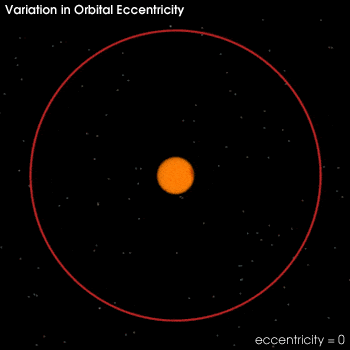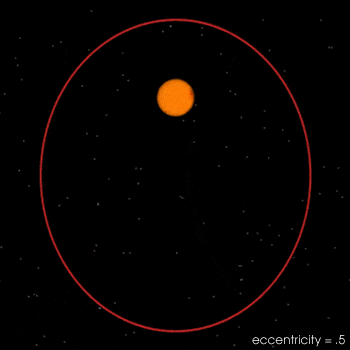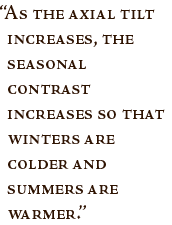Orbital Variations
Changes in orbital eccentricity affect the
Earth-sun distance. Currently, a difference of only 3 percent (5
million kilometers) exists between closest approach (perihelion), which
occurs on or about January 3, and furthest departure (aphelion), which
occurs on or about July 4. This difference in distance amounts to about
a 6 percent increase in incoming solar radiation (insolation) from July
to January. The shape of the Earth’s orbit changes from being
elliptical (high eccentricity) to being nearly circular (low
eccentricity) in a cycle that takes between 90,000 and 100,000 years.
When the orbit is highly elliptical, the amount of insolation received
at perihelion would be on the order of 20 to 30 percent greater than at
aphelion, resulting in a substantially different climate from what we
experience today.


Obliquity (change in axial tilt)
As the axial tilt increases,
the seasonal contrast increases so that winters are colder and summers
are warmer in both hemispheres. Today, the Earth's axis is tilted 23.5
degrees from the plane of its orbit around the sun. But this tilt
changes. During a cycle that averages about 40,000 years, the tilt of
the axis varies between 22.1 and 24.5 degrees. Because this tilt
changes, the seasons as we know them can become exaggerated. More tilt
means more severe seasons—warmer summers and colder winters; less tilt
means less severe seasons—cooler summers and milder winters. It's the
cool summers that are thought to allow snow and ice to last from
year-to-year in high latitudes, eventually building up into massive ice
sheets. There are positive feedbacks in the climate system as well,
because an Earth covered with more snow reflects more of the sun's
energy into space, causing additional cooling.
|
|
 On the Shoulders of Giants
Milutin Milankovitch
Orbital Variations
Milankovitch Theory
Links and References
Left: The eccentricity of the Earth's orbit changes slowly over time from nearly zero
to 0.07. As the orbit gets more eccentric (oval) the difference between the distance
from the Sun to the Earth at perihelion (closest approach) and aphelion (furthest
away) becomes greater and greater. Note that the Sun is not at the center of the
Earth's orbital ellipse, rather it is
at one of focal points.
Note: The eccentricty of the orbit shown in the lower image is a highly
exaggerated 0.5. Even the maximum eccentricity of the Earth's orbit—0.07—it would
be impossible to show at the resolution of a web page. Even so, at the current eccentricity
of .017, the Earth is 5 million kilometers closer to Sun at perihelion than at aphelion. (Images
by Robert Simmon, NASA GSFC) |

Precession
Changes in axial precession alter the dates of
perihelion and aphelion, and therefore increase the seasonal contrast in
one hemisphere and decrease the seasonal contrast in the other
hemisphere.
|
|
Left: The change in the
tilt of the Earth's axis (obliquity) effects the magnitude of
seasonal change. At higher tilts the seasons are more extreme, and at lower tilts
they are milder. The current axial tilt is 23.5°. Image by Robert Simmon, NASA GSFC) |

next: Milankovitch Theory
back: Milutin Milankovitch |
|
Left: Precession—the change in
orientation of the Earth's rotational axis [this can be seen more clearly in an animation (small (290 kB QuickTime)
or large (1.2 MB QuickTime))]—alters the orientation of the Earth with respect to perihelion and
aphelion. If a hemisphere is pointed towards the sun at perihelion, that hemisphere will be pointing away at aphelion, and the
difference in seasons will be more extreme. This seasonal effect is reversed for the opposite hemisphere. Currently, northern summer occurs
near aphelion. (Image by Robert Simmon, NASA GSFC) |



